Gwinn Brothers Milling Company (1889-1962)
Introduction
Text-to-speech Audio
Images
The Gwinn farmhouse in Glenwood, WV

Sketch of the Gwinn Bros. Mill from the 1893 Sanborn fire maps
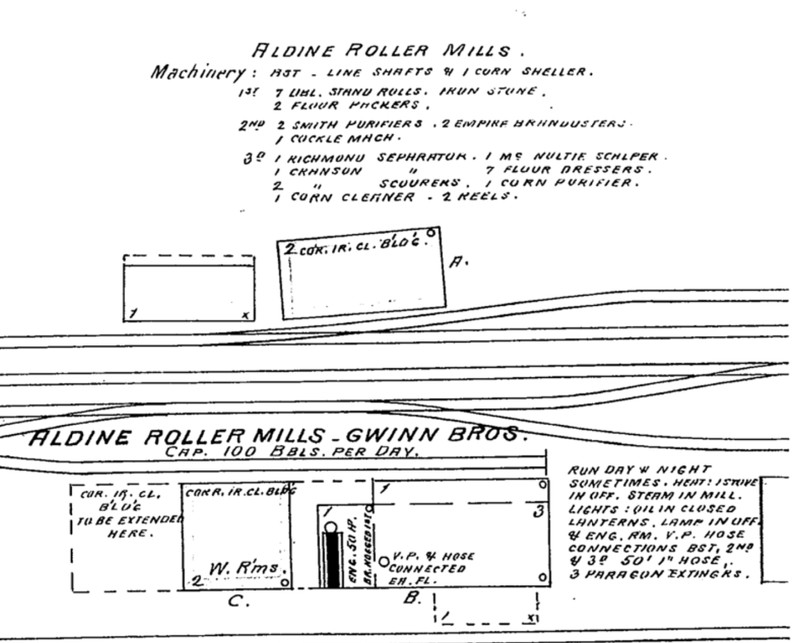
Sketch of the Gwinn Bros. Mill from the 1898 Sanborn fire maps

Sketch of the Gwinn Bros. Mill from the 1904 Sanborn fire maps

Looking towards the Ohio River, with the mill visible in the background, circa 1912
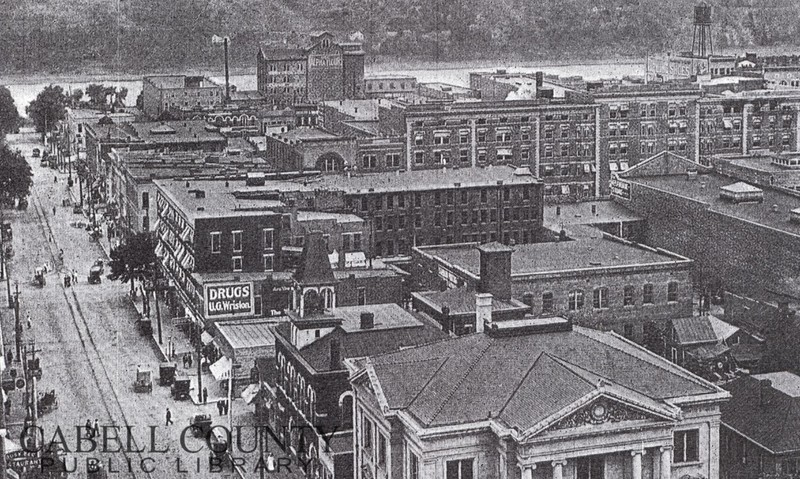
Gwinn Bros. mill, shown at the top left, in 1915
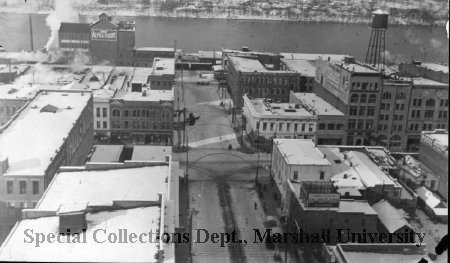
Sketch of the Gwinn Bros. Mill from the 1931 Sanborn fire maps

A building advertising Gwinn Bros. Mill during the 1937 flood
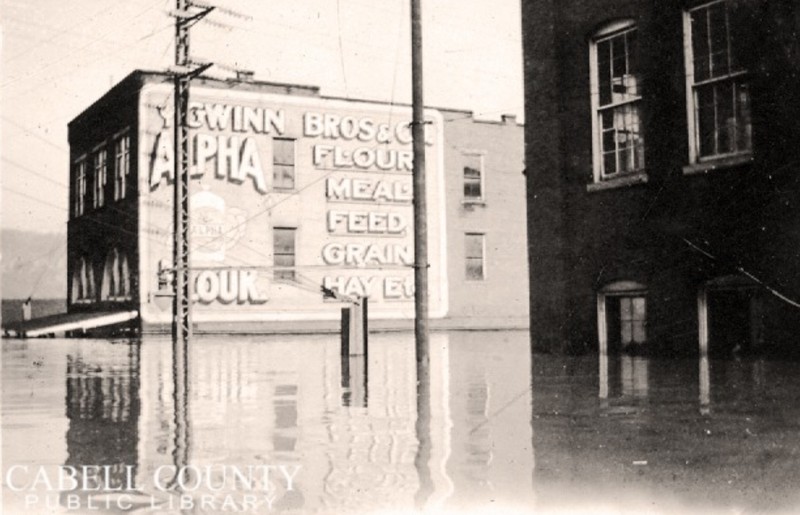
Looking down Second Avenue, with Gwinn Bros. Mill on the left, during the flood of 1937
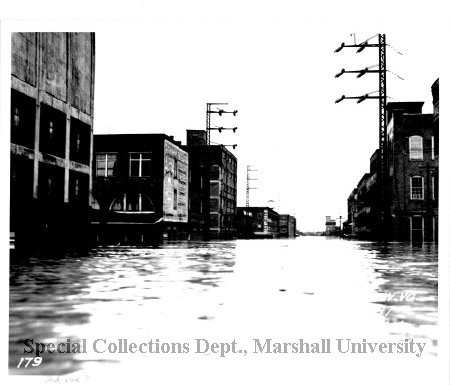
Gwinn Brothers Mill
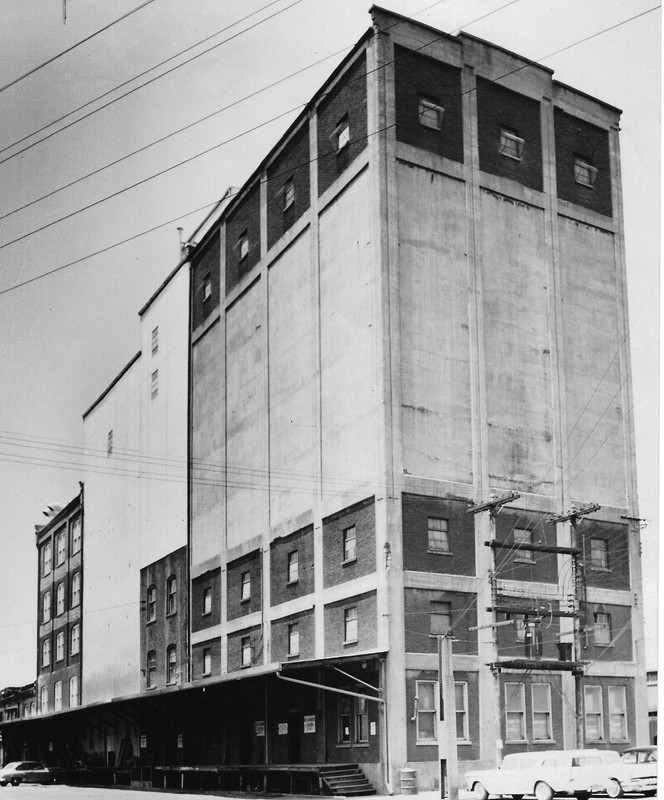
Aerial view of downtown Huntington, with Gwinn Bros Mill visible on the right, in 1960
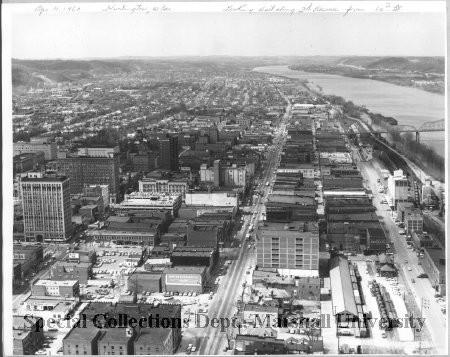
Aerial view of downtown Huntington, with the mill visible at the top left
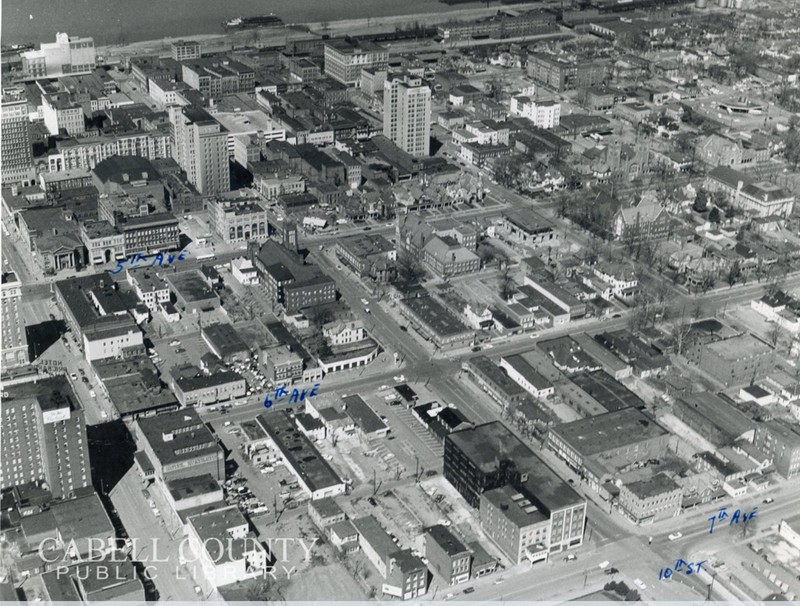
Aerial view of downtown Huntington, with the mill visible at the right
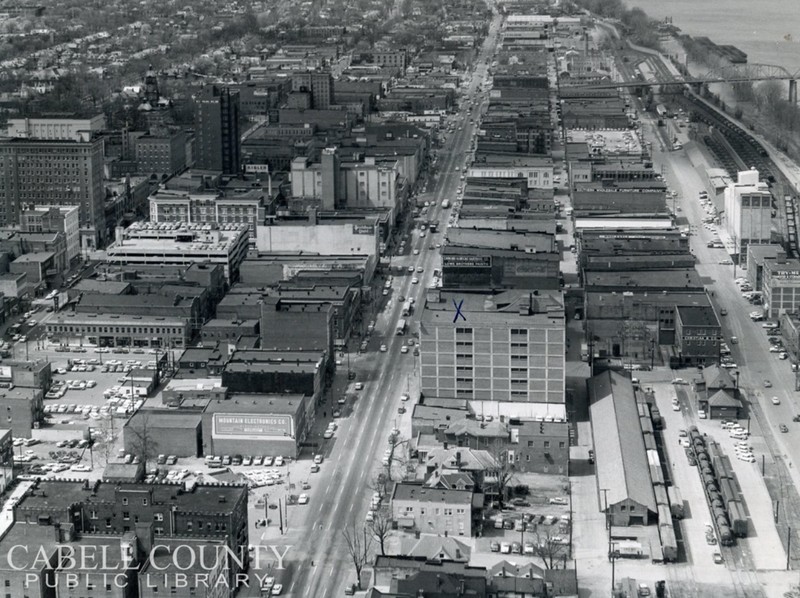
Aerial view of downtown Huntington, with the mill visible at the top
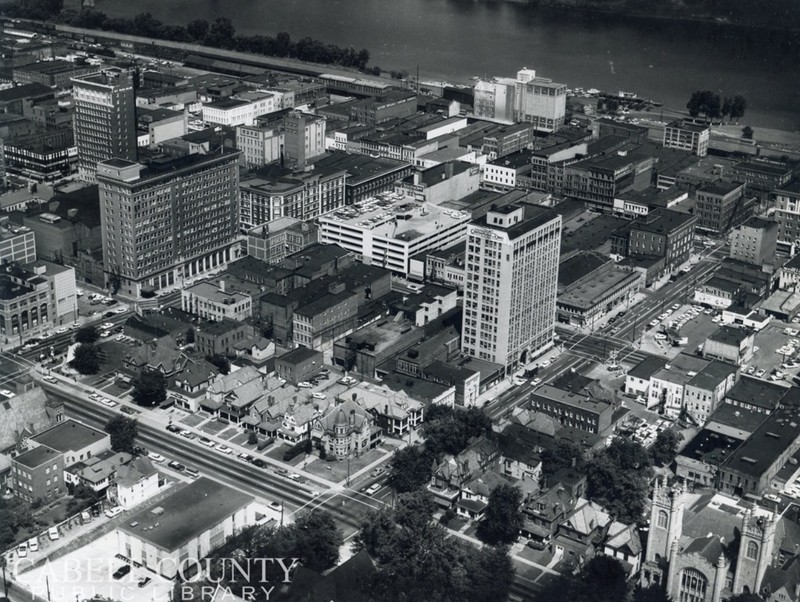
During the 1958 fire
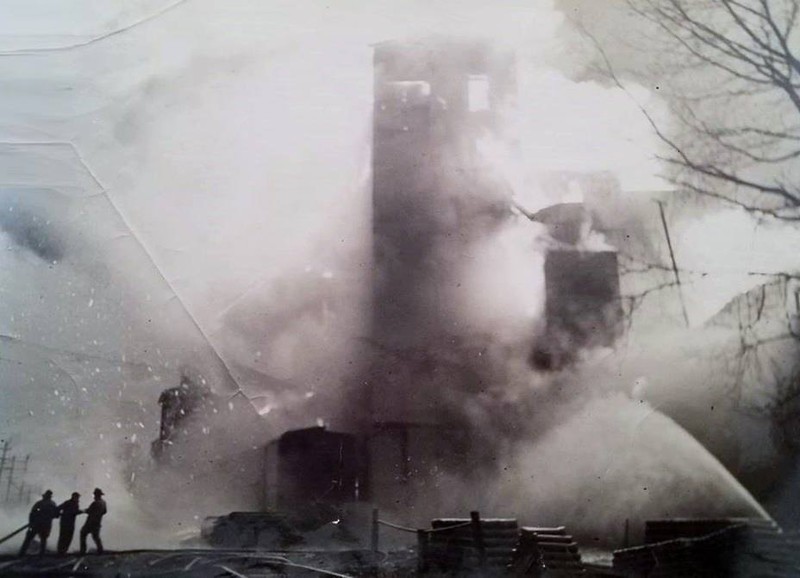
The Superblock

D. Byrd Gwinn's house, now the Marshall University Crime Scene House
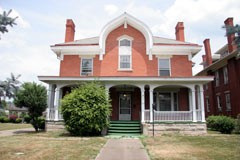
Backstory and Context
Text-to-speech Audio
Members of the Gwinn family settled in Cabell County decades before the city of Huntington was established in 1871. The county’s location along the Ohio River made it a natural stop for settlers following the James River and Kanawha Turnpike as they headed to the western frontier. Irish immigrant John Gwinn, his wife Ruth, and their four children arrived in Cabell County around 1810. Although John Gwinn passed away shortly after the move, the family remained in the area and their children went on to raise families of their own. John’s son Andrew Gwinn, who was born around 1794, was the father of Henry Gwinn, who moved with his family to nearby Mason County around 1860. Henry Gwinn and his wife then had eight children: Othniel Edward, Walter W., Clarence Eugene, Mary Rachel, Minnie A., Van Henry, Martina, and D. Byrd.
Around 1883, Othniel Edward and Walter W. Gwinn opened a grist mill near their family’s general store in Glenwood, Mason County. The mill proved successful, and within a few years, the brothers were producing more flour than they were able to sell locally. They decided to sell the general store, dismantle their mill, and float it down the Ohio River to the foot of Tenth Street in downtown Huntington, where it was officially established as the Gwinn Brothers Milling Company in 1901. The company, which was also referred to as the Aldine Flour Mills, soon grew into a successful business with several buildings that stretched along Second Avenue between Ninth and Eleventh Streets. At its peak, the mill produced hundreds of barrels of flour and cornmeal and hundreds of tons of livestock feed each day. As the largest flour and feed mill in the state, Gwinn Brothers had a vast sales territory that covered southern and central West Virginia, southern Ohio, Kentucky, Virginia and even parts of North Carolina.
Over the years, the Gwinn Brothers Milling Co.’s facilities were rebuilt and expanded a number of times. Along with the mill and two grain elevators, the property also had a three-story office building, warehouse, and a garage building. The youngest of the Gwinn brothers, D. Byrd Gwinn, gradually took on a larger role within the company after completing his education. When Walter W Gwinn passed away in 1915, D. Byrd Gwinn took over as company president. In 1910, Gwinn commissioned Edwin Alger, one of Huntington’s most prominent architects at the time, to design him an elegant home at 1524 Fifth Avenue. The house, which remained in the family for many years, was later purchased by Marshall University and became the Marshall University Forensic Science Center’s Crime Scene House. After D.B. Gwinn passed away in January 1951, his son, James Anderson Gwinn, succeeded him as president of the Gwinn Brothers Milling Company. By that time, however, the business had been struggling for several years, as its export market had shrunk and its equipment had not been modernized. In addition, one of the facility’s feed mills was destroyed by fire in 1946, preventing the company from manufacturing animal feeds for the following year. On January 9, 1958, another fire broke out at the mill, destroying its grain elevator.
James A. Gwinn passed away in 1961. In April of the following year, the remaining members of the Gwinn family decided to sell their majority interests in the company to a wholesale grocery and feed mill company based in Milwaukee. However, the mill was shut down the following year after its new owner announced that it could not make a profit due to the existing competition. In 1964, Martha White Mills took over the operation of the Gwinn Brothers grain elevator and flour mill, as it expanded from its original location on the north side of the 1500 block of 2nd Avenue. In 1970, the mill was demolished in 1970 as part of Huntington’s downtown urban renewal project. A four-block, nine-acre site that included the former Gwinn Bros. facility was created with intentions to redevelop it as a business and recreation district called the Superblock, which ultimately failed to materialize. While various plans for the space were announced over the years, the Superblock sat as a parking lot for thirty years before Pullman Square was completed in 2004.
Cite This Entry
Satterfield, Emma. "Gwinn Brothers Milling Company (1889-1962)." Clio: Your Guide to History. June 25, 2020. Accessed April 28, 2025. https://theclio.com/tour/1596/200
Sources
Brant, Fuller, & Co.. History Of The Great Kanawha Valley [West Virginia] With Family History And Biographical Sketches. Volume 2. Heritage Books, 2007.
Casto, James E. Lost Huntington: Martha White Mills, Huntington Herald-Dispatch. August 27th 2019. Accessed June 25th 2020. https://www.herald-dispatch.com/special/lost_huntington/lost-huntington-martha-white-mills/article_109109eb-61b5-5a9b-a0f6-a6e46f335c8f.html.
Casto, James E. Lost Huntington: The Superblock, Huntington Herald-Dispatch. May 15th 2017. Accessed June 25th 2020. https://www.herald-dispatch.com/special/lost_huntington/lost-huntington-the-superblock/article_6454966f-a387-5404-b800-be9ac9ec82ec.html.
The Herald-Dispatch. Lost Huntington: Gwinn Brothers Mill, Huntington Herald-Dispatch. September 22nd 2014. Accessed June 25th 2020. https://www.herald-dispatch.com/special/lost_huntington/lost-huntington-gwinn-brothers-mill/article_62d06a23-fcdc-5991-a7e3-2c4ff3bc4fc1.html.
Reuther, Catherine. Descendants of John Gwinn, Kennedyreuther.com. February 2nd 2016. Accessed June 25th 2020. http://www.kennedyreuther.com/gwinn/johngwinn_report.pdf.
Thomas, Ella C. Reports of the Tax Court of the United States. Volume 25. Washington, DC. United States Government Printing Office, 1957.
https://marshall.pastperfectonline.com/photo/B747CE76-DC78-4941-AB92-365042232975
http://sanborn.umi.com/browse/wv/9409/47214/49407/662458
http://sanborn.umi.com/browse/wv/9409/47215/49408/662473
http://sanborn.umi.com/browse/wv/9409/47216/49409/662502
https://cabe.ent.sirsi.net/client/en_US/test/?rm=DANIEL+MCMILLI0%7C%7C%7C1%7C%7C%7C0%7C%7C%7Ctrue&dt=list
https://marshall.pastperfectonline.com/photo/689CBC03-B727-4FD1-AB63-623494762130
http://sanborn.umi.com/browse/wv/9409/47218/49411/662542
https://cabe.ent.sirsi.net/client/en_US/test/?rm=1937+FLOOD+VIE0%7C%7C%7C1%7C%7C%7C0%7C%7C%7Ctrue&dt=list
https://marshall.pastperfectonline.com/photo/A5BBB30D-CB2D-4937-8068-211534754446
https://www.herald-dispatch.com/special/lost_huntington/lost-huntington-gwinn-brothers-mill/article_62d06a23-fcdc-5991-a7e3-2c4ff3bc4fc1.html
https://marshall.pastperfectonline.com/photo/E45F7C91-3C17-45CA-A29E-301407156200
https://cabe.ent.sirsi.net/client/en_US/test/?rm=GRADY+RISEN+CO0%7C%7C%7C1%7C%7C%7C0%7C%7C%7Ctrue&dt=list
https://cabe.ent.sirsi.net/client/en_US/test/?rm=GRADY+RISEN+CO0%7C%7C%7C1%7C%7C%7C0%7C%7C%7Ctrue&dt=list
https://cabe.ent.sirsi.net/client/en_US/test/?rm=GRADY+RISEN+CO0%7C%7C%7C1%7C%7C%7C0%7C%7C%7Ctrue&dt=list
https://www.facebook.com/photo.php?fbid=1721593077880878&set=p.1721593077880878&type=3&theater
https://www.herald-dispatch.com/special/lost_huntington/lost-huntington-the-superblock/article_6454966f-a387-5404-b800-be9ac9ec82ec.html
https://www.marshall.edu/forensics/about/crimescenehouse

